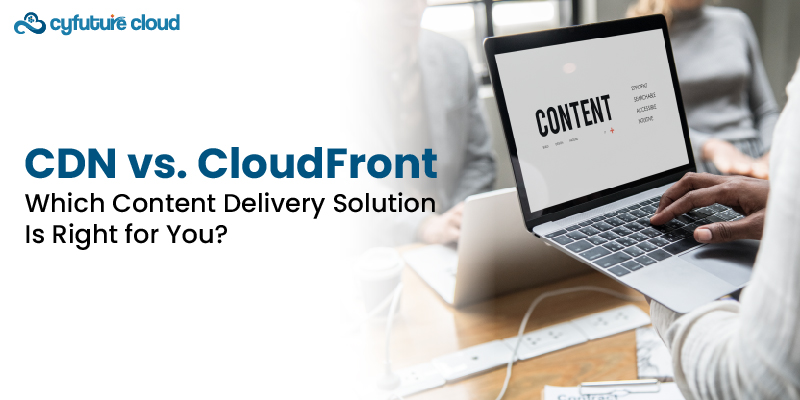 Server
Colocation
Server
Colocation
 CDN
Network
CDN
Network
 Linux Cloud
Hosting
Linux Cloud
Hosting
 VMware Public
Cloud
VMware Public
Cloud
 Multi-Cloud
Hosting
Multi-Cloud
Hosting
 Cloud
Server Hosting
Cloud
Server Hosting
 Kubernetes
Kubernetes
 API Gateway
API Gateway


Content delivery networks (CDNs) play a crucial role in improving website performance and user experience. Two popular options in this space are generic CDN solutions and Amazon CloudFront. This article will compare these two approaches to help you determine which content delivery solution best fits your needs.
1. Overview
CDN:
A CDN is a system of distributed servers that, operating cohesively, work to supply the user’s web content based on the location of the user. CDNs replicate content at different PoPs through the world in order to minimize delivery time and increase the loading time of the content in the viewer’s client machine.
CloudFront:
AWS CloudFront is a specific solution with CDN (Content Delivery Network) orientation realized by Amazon. It also works well with other AWS platforms and has an extensive edge location to deliver content such as APIs and applications.
2. Global Reach and Performance
CDN:
- Generic CDNs often have extensive global networks with numerous PoPs.
- Performance can vary depending on the provider, but many offer robust global coverage.
- Some CDNs specialize in specific regions or use cases.
CloudFront:
- Leverages AWS's global cloud infrastructure with a large number of edge locations worldwide.
- Offers consistent performance across regions due to its integration with AWS's network.
- Provides low-latency content delivery through its extensive network.
3. Integration and Ease of Use
CDN:
- Can be used with any origin server or web hosting platform.
- May require more manual configuration and management.
- Often provides APIs and management tools for integration.
CloudFront:
- Integrates with other AWS services (such as S3, EC2, and elastic load balancing) seamlessly.
- The AWS Management Console makes setup and management simple.
- Offers AWS SDK support for programmatic management.
4. Caching and Content Management
CDN:
- Typically offers flexible caching options and configuration.
- May provide advanced cache purging and invalidation features.
- Often includes tools for managing different types of content (static, dynamic, streaming).
CloudFront:
- Provides customizable caching behaviors and TTL settings.
- Offers real-time content invalidation.
- Supports various content types, including static, dynamic, and streaming media.
- Integrates with AWS Lambda@Edge for custom content processing at the edge.
5. Security Features
CDN:
- Often includes basic DDoS protection.
- May offer WAF (Web Application Firewall) capabilities.
- SSL/TLS support for secure content delivery.
CloudFront:
- Integrated with AWS Shield for DDoS protection.
- AWS WAF can be used for advanced threat protection.
- Supports custom SSL certificates and SNI (Server Name Indication).
- Offers field-level encryption for sensitive data.
6. Pricing and Cost Management
CDN:
- Pricing models vary by provider, often based on bandwidth usage and requests.
- May offer volume discounts or committed use discounts.
- Some providers offer predictable flat-rate pricing.
CloudFront:
- Pay-as-you-go pricing based on data transfer out and number of requests.
- Offers price classes to optimize costs based on geographic reach.
- Integrates with AWS Cost Explorer for detailed cost analysis and forecasting.
7. Analytics and Monitoring
CDN:
- Analytics capabilities vary by provider.
- May offer real-time logging and reporting.
- Some providers offer advanced analytics for performance optimization.
CloudFront:
- Integrates with Amazon CloudWatch for monitoring and alarms.
- Provides real-time logging to Amazon S3.
- Offers detailed cache statistics and viewer request analytics.
8. Customization and Advanced Features
CDN:
- Customization options vary by provider.
- Some CDNs offer advanced features like image optimization or bot management.
- May provide APIs for custom integrations and workflows.
CloudFront:
- Supports Lambda@Edge for custom code execution at edge locations.
- Offers field-level encryption for protecting sensitive data.
- Integrates with AWS WAF for customizable security rules.
- Supports origin failover for high availability.
9. Support and Documentation
CDN:
- Support quality and availability can vary by provider.
- Documentation depth and quality may differ between CDN providers.
CloudFront:
- Backed by AWS support plans, including 24/7 support options.
- Extensive documentation and learning resources available.
- Large community and ecosystem for knowledge sharing.
10. Use Cases and Considerations
CDN:
- Ideal for businesses not heavily invested in the AWS ecosystem.
- Good choice for multi-cloud or hybrid cloud strategies.
- May offer specialized solutions for specific industries or content types.
CloudFront:
- Best for businesses already using or planning to use other AWS services.
- Excellent for dynamic content acceleration when used with AWS origins.
- Suitable for organizations looking for tight integration with cloud hosting services.
Choosing Between CDN and CloudFront
Consider a generic CDN if:
- You're not heavily invested in the AWS ecosystem.
- You need specific features or regional optimizations offered by a particular CDN provider.
- You're implementing a multi-cloud strategy and want to avoid vendor lock-in.
Consider CloudFront if:
- You're already using or planning to use other AWS services.
- You want seamless integration with AWS security and management tools.
- You need advanced features like Lambda@Edge for custom processing at the edge.
- You prefer a pay-as-you-go model with detailed cost management tools.
Conclusion
Both generic CDNs and Amazon CloudFront offer powerful content delivery capabilities. Your choice ultimately depends on your specific needs, existing infrastructure, budget, and long-term cloud strategy. Generic CDNs provide flexibility and may offer specialized features, while CloudFront excels in AWS integration and offers advanced capabilities like Lambda@Edge. Carefully evaluate your requirements and consider factors such as performance, ease of use, security, and cost to make the best decision for your organization.

Let’s talk about the future, and make it happen!
By continuing to use and navigate this website, you are agreeing to the use of cookies.
Find out more


